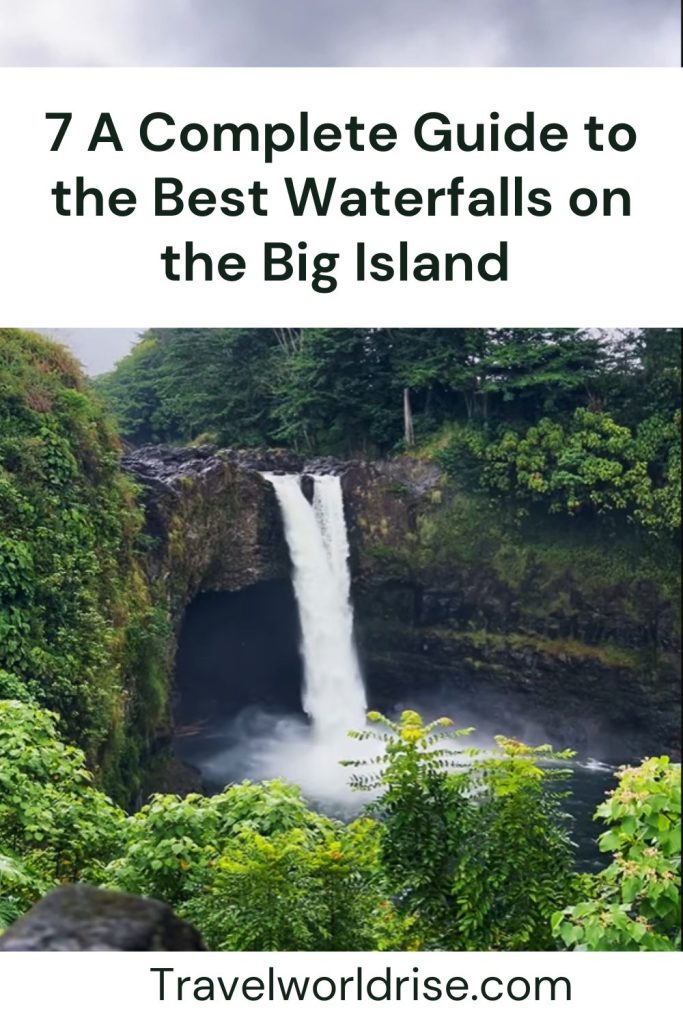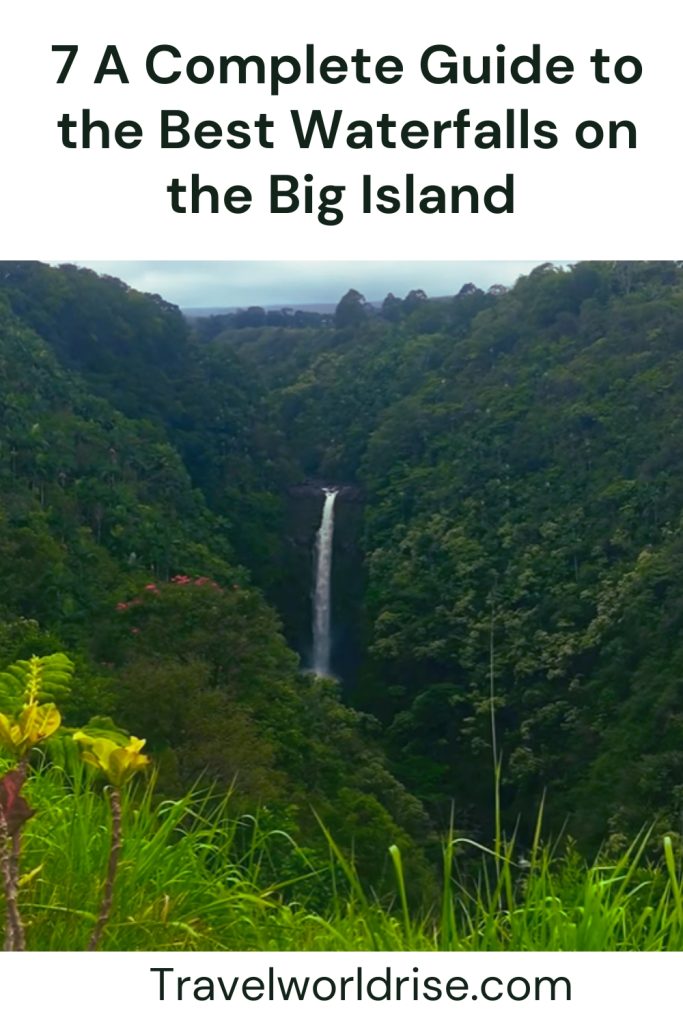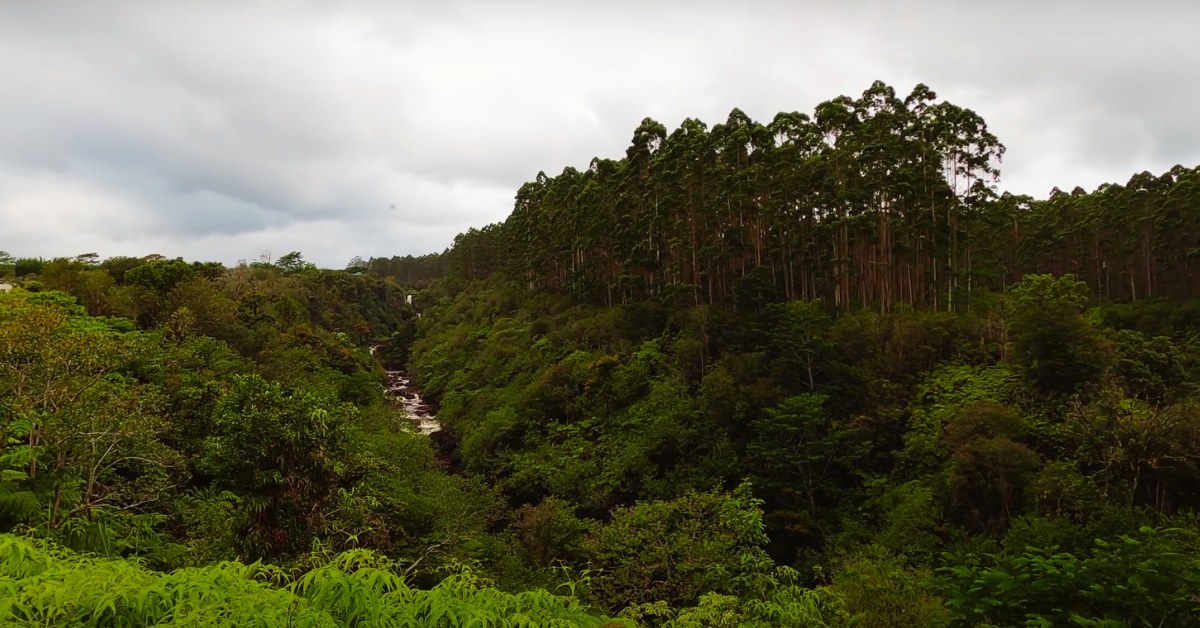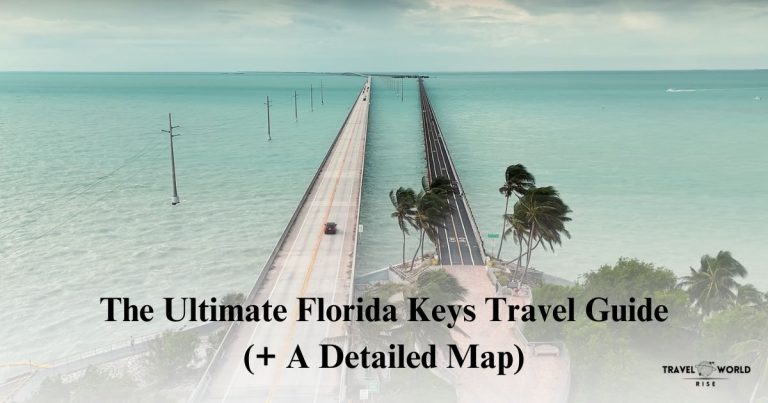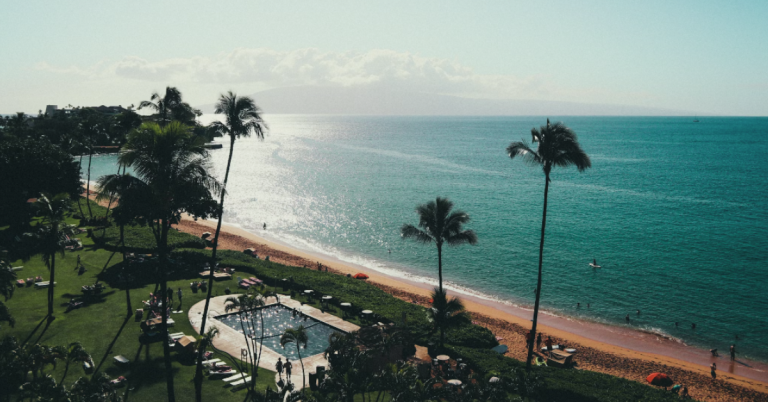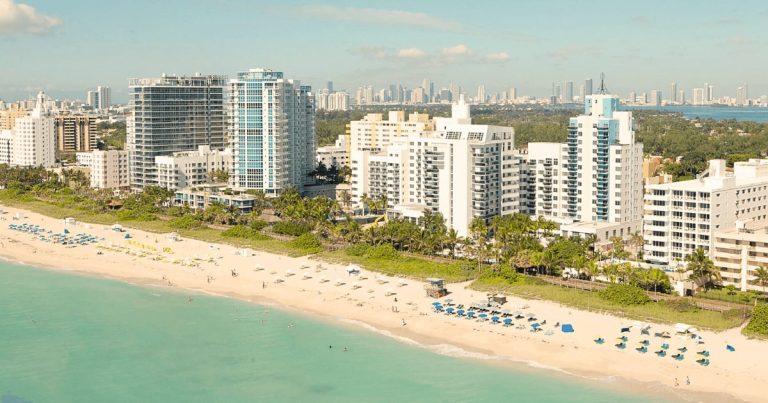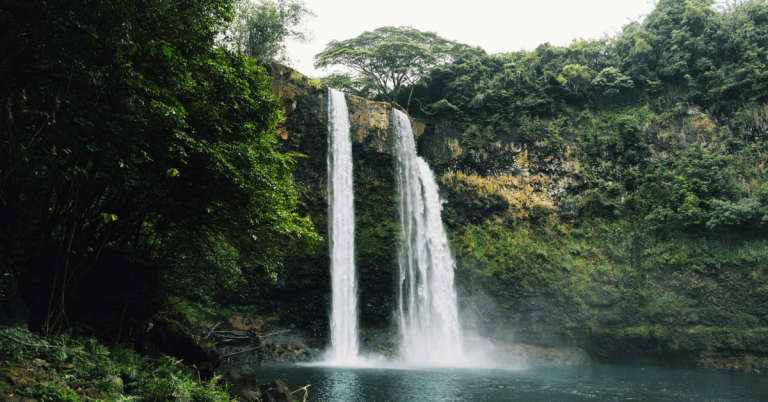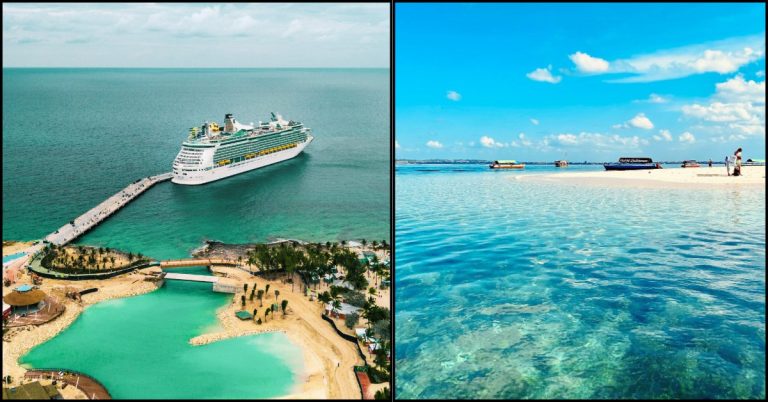7 A Complete Guide to the Best Waterfalls on the Big Island
This post may contain affiliate links, meaning we may earn a commission at no additional cost if you decide to purchase through links.
If you’re planning a trip to hawaii and wondering to see the best waterfalls on the Big Island? You’re in the right place. We’ll dive into including everything about the Big Island’s waterfalls.
From iconic destinations and the breathtaking like ‘Akaka Falls to the secluded gems of the Kohala Coast, the Big Island is home to some of the most awe-inspiring waterfalls you’ll ever see. After spending days hiking, swimming, and exploring these incredible spots, we couldn’t get enough of the island’s natural beauty.
In this guide, we’ll share everything you need to know to plan the ultimate Big Island waterfall adventure. we’ll discover the easiest-to-access falls, swim-friendly spots, and even hidden treasures only accessible by guided tours. Plus, we’ve included tips, detailed maps, and answers to all your FAQs to make your trip seamless. Get ready to dive into the lush landscapes and cascading waters of Hawaii’s Big Island.
Table of Contents
A Complete Trip Guide to the Best Waterfalls on the Big Island
When to Visit:
-The great time is April/May (best weather and shoulder season)
– Winter season is December – March (also whale season!)
– Summer our favourate time (July-August) is very warm and amount of crowds.
Things to Do:
Whale Watching Cruise (The only time we recommend in the winter!)
Snorkel with Manta Rays (the Best activity to do on the Big Island!)
Mauna Kea Stargazing Adventure (lil bit pricey but you get wonderfull and unique experience)
Check Our The A Complete:The Ultimate Hawaii Travel Guide
A Quick Look at the Best Waterfalls on the Big Island
Overview of the Big Island’s Geography and Climate
The Big Island, officially called Hawai‘i Island, is the largest and youngest of the Hawaiian Islands, covering over 4,000 square miles. Its unique geography is shaped by five major volcanoes: Mauna Loa, Mauna Kea, Hualālai, Kīlauea, and Kohala. This volcanic activity has created a dramatic landscape of lush rainforests, rugged coastlines, and lava fields.
The island’s climate is just as diverse as its geography. Depending on where you are, you can experience everything from tropical rainforests on the east side to arid desert conditions on the west side. Thanks to the trade winds, the eastern regions, like Hilo and the Hamakua Coast, receive ample rainfall, making them the perfect environment for waterfalls to flourish.
Why the Big Island Is Home to So Many Waterfalls
Waterfalls are abundant on the Big Island due to the high rainfall on its windward side. The warm, moist trade winds hit the slopes of Mauna Kea and Mauna Loa, where the air cools and condenses, resulting in frequent rain showers. This consistent rainfall feeds into countless streams and rivers that cascade down the island’s volcanic slopes, forming breathtaking waterfalls along the way.
Additionally, the island’s steep cliffs and valleys, carved over centuries by erosion and volcanic activity, create the perfect natural pathways for waterfalls. The Hamakua Coast, with its dramatic drop-offs and fertile landscapes, is one of the most waterfall-rich areas on the island.
What to Expect When Exploring the Island’s Waterfalls
Visiting waterfalls on the Big Island is an adventure in itself! Many are easily accessible by car, while others require a bit of hiking or even guided tours. Expect to encounter a mix of well-maintained state parks, like ‘Akaka Falls, and off-the-beaten-path spots that offer a more rugged experience.
Most waterfalls are surrounded by lush tropical vegetation, so prepare for a rainforest vibe, complete with occasional light rain showers. Bring a rain jacket, comfortable walking shoes, and bug spray. If you plan to swim in some of the waterfalls, such as Kulaniapia Falls, a swimsuit and water shoes are essential.
Each waterfall has its own charm, from towering cascades like Hi‘ilawe Falls to picturesque spots like Rainbow Falls. And don’t forget your camera! The views, misty rainbows, and vibrant greenery make these spots a photographer’s paradise.
Big Island Waterfalls Map
Visual Guide Showing the Locations of Key Waterfalls
A map is your best friend when exploring the Big Island’s stunning waterfalls. Key waterfalls like ‘Akaka Falls, Rainbow Falls, Umauma Falls, and Kulaniapia Falls are clustered around the lush eastern side of the island, particularly near Hilo and the Hamakua Coast. You’ll also find hidden gems in the Kohala region and Waipi‘o Valley.
Using a detailed Big Island map, whether printed or digital, can help you visualize these clusters and plan a route that makes the most of your time. Many maps, such as those from visitor centers or guidebooks, include helpful icons for waterfalls, hiking trails, and scenic spots. Online tools like Google Maps or AllTrails also allow you to create a custom itinerary with turn-by-turn directions.
Tips for Using the Map for Trip Planning
- Group Nearby Waterfalls: Plan to visit waterfalls that are close to each other. For instance, you can combine ‘Akaka Falls with nearby Umauma Falls in a single outing or pair Rainbow Falls with Peepee Falls and Boiling Pots.
- Check Driving Times: While the Big Island may not seem huge on a map, driving between destinations can take longer than expected due to winding roads and diverse terrains. Always account for extra travel time, especially if you’re heading to remote areas like Waipi‘o Valley or the Kohala Coast.
- Mark Amenities: Some waterfalls are part of state parks with restrooms, picnic areas, and parking, while others are on private property or in undeveloped areas. Make a note of which locations offer these amenities so you can plan accordingly.
- Weather Considerations: Rain can affect accessibility to some areas, especially in valleys or dirt roads. Use the map to identify alternative stops in case conditions change unexpectedly.
Driving Distances and Accessibility
Here’s a quick overview of approximate driving times to major waterfalls from Hilo and Kona, two of the island’s main hubs:
- Akaka Falls: ~25 minutes from Hilo, ~2 hours from Kona
- Rainbow Falls: ~5 minutes from Hilo, ~2 hours from Kona
- Umauma Falls: ~20 minutes from Hilo, ~2 hours from Kona
- Kulaniapia Falls: ~20 minutes from Hilo, ~2 hours from Kona
- Hi‘ilawe Falls (Waipi‘o Valley): ~1.5 hours from Hilo, ~2.5 hours from Kona
- Kohala Coast Waterfalls: ~1 hour from Waimea, ~1.5 hours from Kona
Accessibility Tips:
- Many waterfalls are easily accessible with paved paths or short walks, like Rainbow Falls and ‘Akaka Falls.
- For remote spots like Hi‘ilawe Falls, a 4WD vehicle may be required to navigate rough roads.
- Some waterfalls, such as those in Waipi‘o Valley, require hiking down steep trails or joining guided tours.
A well-planned route with a reliable map ensures you don’t miss out on any must-see spots while maximizing your time on the island. Let me know if you’d like me to expand on any of these details or add specific map suggestions!
Waterfalls on the Big Island That Are Easy to Access
Akaka Falls and Kahuna Falls
Overview of the ‘Akaka Falls State Park
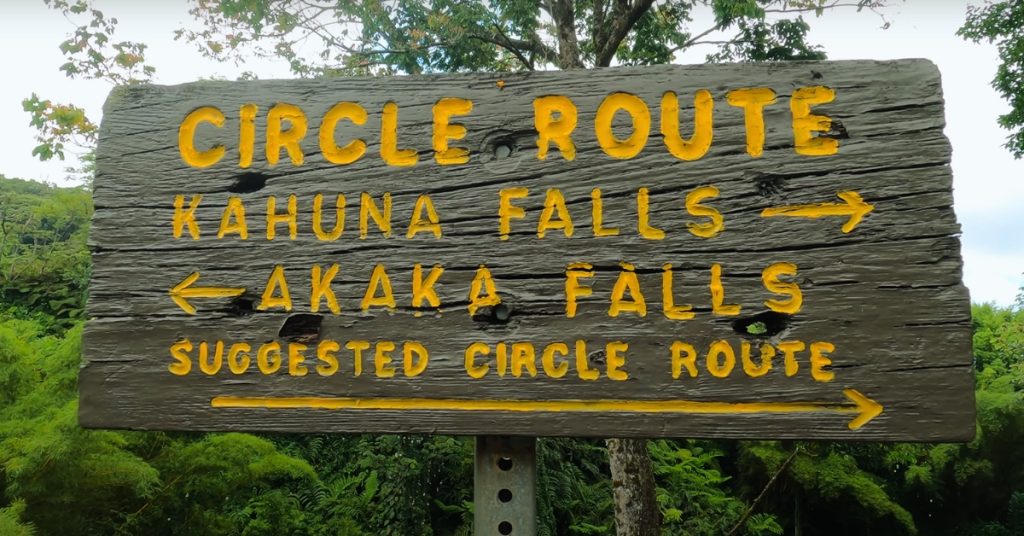
‘Akaka Falls State Park, located about 25 minutes from Hilo, is one of the most iconic destinations on the Big Island. The park is home to two stunning waterfalls: the towering 442-foot ‘Akaka Falls and the smaller yet beautiful Kahuna Falls, which cascades down into the lush valley below. The park features a paved, looped trail of about 0.4 miles, making it a quick and easy way to experience the natural beauty of Hawaii’s rainforest.
As you walk the trail, you’ll be surrounded by vibrant tropical plants, such as bamboo, orchids, and ferns. The loop includes plenty of photo opportunities, with ‘Akaka Falls offering a jaw-dropping view from the main lookout point. Kahuna Falls is slightly obscured by the thick greenery but still worth catching a glimpse of from designated viewpoints.
Why This Is a Must-Visit Spot for Families and Beginners

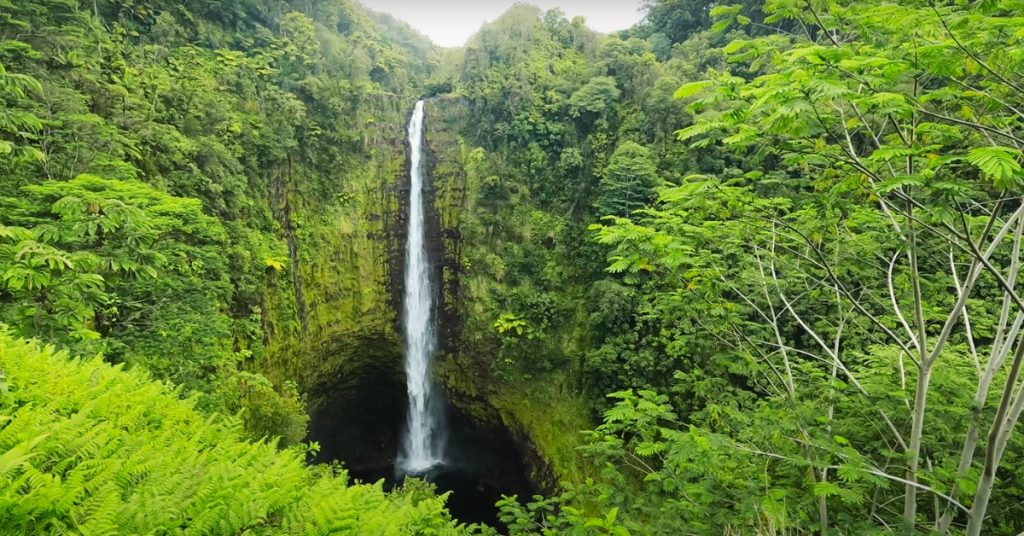
‘Akaka Falls State Park is perfect for families and those who want an accessible and low-effort adventure. The trail is well-maintained, with railings and stairs, making it suitable for visitors of all ages and fitness levels. You don’t need to be an experienced hiker to enjoy the sights here!
The short loop also makes this park an excellent option if you’re short on time or looking for a quick stop. It’s one of those places where you can immerse yourself in Hawaii’s natural beauty without breaking a sweat. Plus, the park has designated parking and restrooms, making it incredibly convenient for families with kids.
Rainbow Falls
Location and Best Times to Visit for Rainbows
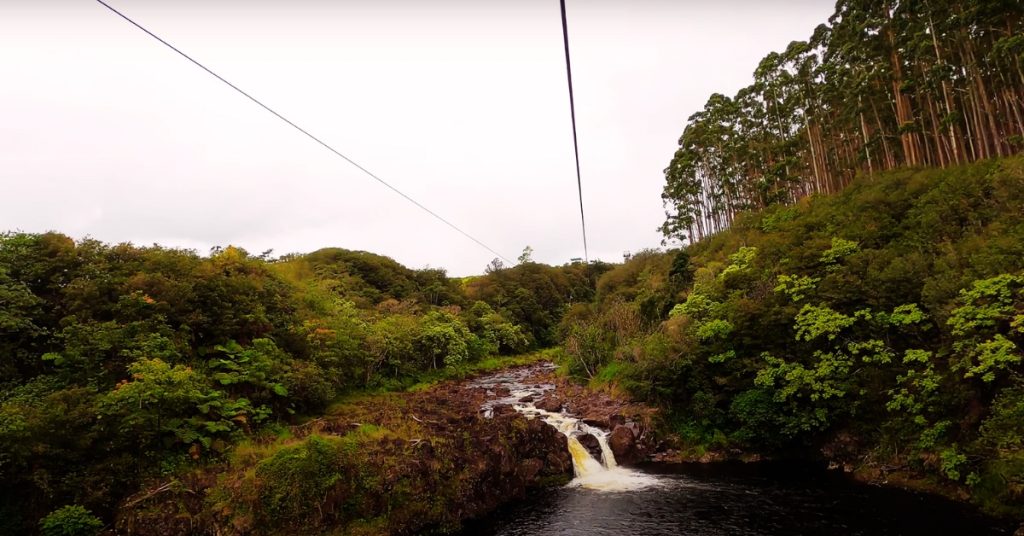
Rainbow Falls is located just a few minutes from downtown Hilo, making it one of the most accessible waterfalls on the island. This 80-foot cascade is famous for its morning rainbows, which appear when sunlight hits the misty spray of the falls at the right angle.
For the best chance to see these rainbows, plan your visit early in the morning, ideally between 7:00 and 9:00 a.m. The light conditions are perfect during this time, especially on clear days. Even if you miss the rainbows, the waterfall’s beauty and the surrounding tropical vegetation are more than worth the visit.
Facilities and Accessibility Details
Rainbow Falls is part of Wailuku River State Park and offers free entry, making it an easy and budget-friendly stop. The parking lot is spacious and just steps away from the main viewing platform, so there’s no need for long walks or hikes.
For those looking to explore further, a short trail leads to the top of the falls, offering a unique perspective of the rushing water. The area is also wheelchair-accessible, making it an excellent choice for travelers with mobility concerns.
The park features restrooms and picnic tables, making it a great spot for a morning snack or a relaxed break while taking in the scenery. It’s a no-fuss destination that perfectly combines convenience and natural beauty.
These easily accessible waterfalls offer a chance to experience the awe of Hawaii’s natural landscapes without the challenge of long hikes or difficult terrain. Let me know if you’d like to dive deeper into any other waterfalls or sections!
Waterfalls on the Big Island You Can Swim In
Kulaniapia Falls
Details About the Waterfall’s Location on Private Property
Kulaniapia Falls is a hidden gem located on a private property near Hilo, offering a serene and exclusive experience. This stunning 120-foot waterfall is nestled within a lush bamboo forest and flows into a crystal-clear pool, making it a perfect spot for swimming. Unlike many public waterfalls on the Big Island, Kulaniapia offers an intimate setting, far removed from the crowds.
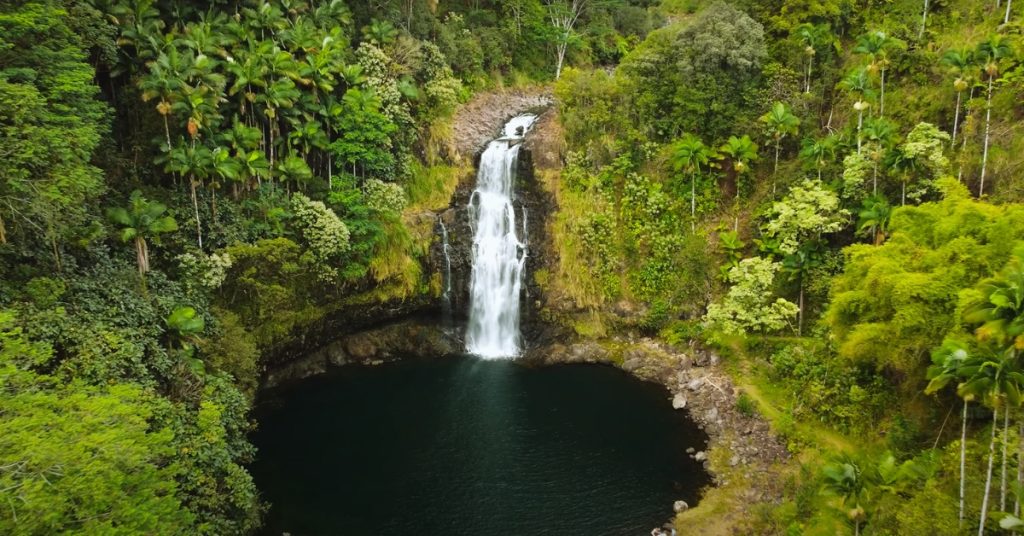
The property is part of the Kulaniapia Falls Inn, a boutique eco-resort that focuses on sustainability and providing guests with a peaceful retreat. Whether you’re a guest at the inn or visiting with a day pass, this destination feels like your own slice of paradise.
How to Access It via Reservations
Access to Kulaniapia Falls requires a reservation, either as a guest staying at the inn or through their day-use passes. Day passes allow non-guests to enjoy the falls, including swimming, kayaking, and paddleboarding in the pool beneath the cascade.
Reservations can be made online through the property’s website, and day passes often include access to the hiking trails around the falls. Visitors are encouraged to book in advance, as the limited capacity ensures that the experience remains private and uncrowded. If you’re looking for a more luxurious experience, consider staying overnight at the inn for full access to the property and falls.
Umauma Falls
Swimming Options and Nearby Activities Like Ziplining
Umauma Falls is a triple-tiered waterfall located within the Umauma Experience Adventure Park, about 20 minutes north of Hilo. While the falls themselves are primarily a viewing spot, the park offers a man-made swimming pond nearby where visitors can take a refreshing dip. The pond is fed by natural streams, providing a safe and relaxing spot for water activities.
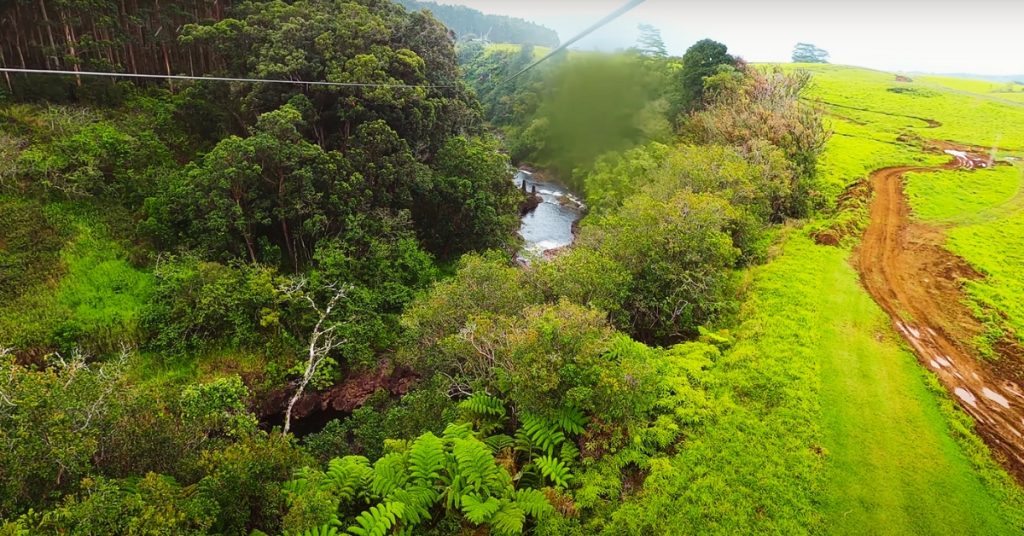
One of the park’s major draws is its ziplining tours, which allow adventure seekers to soar over the Umauma River and enjoy aerial views of the waterfalls. Other activities include kayaking and paddleboarding, making Umauma Falls an excellent destination for those who want to combine a swim with a full day of outdoor fun.
Why It’s Perfect for Adventure Seekers
Umauma Falls is ideal for thrill-seekers and families looking for an action-packed day. The ziplining tours feature multiple lines, including a dual line for racing a friend, and some zip lines stretch over 2,000 feet!

After a morning of adventure, the swimming pond provides a great way to cool off and relax. The park also has picnic areas, so you can refuel before exploring more of the property or visiting nearby attractions. With its mix of natural beauty and adrenaline-pumping activities, Umauma Falls offers something for everyone.
Both Kulaniapia Falls and Umauma Falls cater to different types of visitors: Kulaniapia is perfect for those seeking a tranquil and private experience, while Umauma Falls offers a blend of swimming and exciting outdoor activities. Let me know if you’d like more details or tips for visiting!
Kohala Coast Waterfalls
Overview of Kohala’s Unique Landscape and Waterfalls
The Kohala Coast, located on the northernmost tip of the Big Island, is a treasure trove of natural beauty. As the oldest part of the island, Kohala boasts rugged cliffs, lush valleys, and cascading waterfalls that have been shaped over millennia by volcanic activity and erosion. This area is home to some of the most secluded and breathtaking waterfalls on the island, often hidden within verdant valleys or accessible only by guided tours.
What sets Kohala apart is its dramatic landscape, where waterfalls tumble down steep, forested cliffs into pristine pools and streams. The valleys, such as Pololū and Waipi‘o, are particularly notable for their untouched beauty and spiritual significance to Native Hawaiians. Kohala’s waterfalls, surrounded by dense rainforest and steep ridges, create a serene yet awe-inspiring atmosphere that feels like stepping back in time.
Guided Tours That Explore Hidden Gems in the Area
Due to the remote and rugged nature of many Kohala Coast waterfalls, guided tours are often the best way to access these hidden gems. These tours typically use 4WD vehicles or even helicopters to navigate challenging terrains and provide visitors with a safe and informative experience.
Some popular guided tour options include:
- Kohala Waterfalls Adventure: This tour combines off-road exploration with short hikes to multiple waterfalls. Along the way, guides share insights about the region’s geology, history, and native flora and fauna.
- Helicopter Tours: For a bird’s-eye view, helicopter tours from Kona or Waimea provide stunning aerial perspectives of Kohala’s valleys and waterfalls. This is a great way to see remote spots that are otherwise inaccessible.
- Waipi‘o Valley Expeditions: These tours delve deep into the sacred Waipi‘o Valley, offering a mix of cultural education and close-up views of its waterfalls.
Guides often share fascinating stories and legends tied to the waterfalls, adding a cultural layer to the experience. Plus, tours ensure that visitors respect the natural environment and private lands they may traverse.
Waipi‘o Valley in Kohala’s Waterfall Offerings
Waipi‘o Valley, often referred to as the “Valley of the Kings,” is one of the most significant and visually striking areas on the Kohala Coast. This expansive valley, with its steep cliffs and lush greenery, is home to some of the island’s tallest waterfalls, including the majestic Hi‘ilawe Falls, which plunges over 1,400 feet, making it one of the highest in Hawaii.
In addition to its waterfalls, Waipi‘o Valley holds deep cultural and historical importance. It was once a thriving center of Hawaiian civilization and remains a sacred place for many locals. Visitors can hike or join guided tours to access the valley’s waterfalls, as driving down the steep access road requires a 4WD vehicle and experience navigating challenging terrain.
The valley’s waterfalls are fed by abundant rainfall and natural springs, which also sustain the taro fields and streams that crisscross the valley. Exploring Waipi‘o Valley offers a unique opportunity to witness the harmony of nature and culture in one of Hawaii’s most breathtaking settings.
Whether you’re seeking adventure, cultural immersion, or a peaceful escape, Kohala’s waterfalls deliver an unforgettable experience. Let me know if you’d like more recommendations or details about the Kohala region!
Frequently Asked Questions About Waterfalls on the Big Island
Where are the most waterfalls on the Big Island?
Most of the waterfalls on the Big Island can be found on the lush eastern side, particularly around Hilo and along the Hamakua Coast. These areas are blessed with abundant rainfall, creating the perfect conditions for waterfalls to thrive! The tropical landscape here makes it a waterfall lover’s dream.
Can you swim in any waterfalls on the Big Island?
Yes, you can! However, most of the swim-friendly waterfalls require either an entrance fee or a guided tour to access them. If you’re planning to take a dip, be sure to check out the section below, where I’ve listed all the best waterfalls for swimming!
What is the biggest waterfall on the Big Island?
The tallest waterfall on the Big Island is Hi‘ilawe Falls, located in the legendary Waipi‘o Valley. It’s not just the biggest waterfall on the island it’s the tallest waterfall in all of Hawaii! Its breathtaking 1,400-foot drop is truly a sight to behold.
Are there guided tours to waterfalls on the Big Island?
Absolutely! In fact, some of the most stunning waterfalls, especially those in remote areas, can only be reached through guided tours. I’ll cover the best tours you can book later in this guide, so keep reading!
Do all waterfalls on the Big Island have entrance fees?
Not at all! There are plenty of waterfalls, like Rainbow Falls, that you can visit for free. For others, such as ‘Akaka Falls or those on private property, there may be a small entrance fee. I’ve made sure to include this info for each waterfall mentioned below!
Is it safe to swim in waterfalls on the Big Island?
Safety depends on a few factors. Waterfalls can be prone to flash floods, especially after heavy rain, which makes swimming extremely dangerous. Always check weather conditions and posted warnings before taking a dip.
Additionally, freshwater on the Big Island can carry leptospirosis, a bacterial infection that thrives in rivers and streams. Hawaii has the highest rate of leptospirosis in the U.S., so avoid swimming if you have open cuts or sores, and keep your head above water to reduce your risk. A little preparation goes a long way in keeping your waterfall adventures safe and enjoyable!
Final Thoughts
The Big Island of Hawaii! Whether you’re chasing towering cascades like Hi‘ilawe Falls or stopping by easy-access gems like Rainbow Falls, the island offers a waterfall adventure for everyone. From epic hikes to roadside wonders, there’s no shortage of stunning options to explore.
If you’re planning your trip, we highly recommend spending a few days on the Hilo side of the island. As shown on the map earlier in this guide, the majority of the Big Island’s waterfalls are clustered in this lush, tropical region. Staying nearby makes it so much easier to maximize your time and fully experience the natural beauty this area has to offer.
So grab your map, pack your swimsuit, and get ready to chase some incredible waterfalls Hawaii-style! Have you visited any of these waterfalls? Let me know your favorites, or share your tips in the comments below. Happy adventuring.
